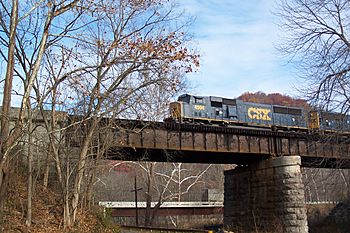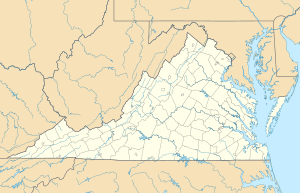Jackson River (Virginia) facts for kids
Quick facts for kids Jackson River |
|
|---|---|

|
|
|
Location of the mouth of the Jackson River in Virginia
|
|
| Other name(s) | Jacksons River, Jackson's River |
| Country | United States |
| State | Virginia |
| County | Alleghany County, Botetourt County, Bath County, Highland County |
| Physical characteristics | |
| Main source | Appalachian Mountains, Highland County, Virginia 38°26′7″N 79°38′35″W / 38.43528°N 79.64306°W |
| River mouth | James River Alleghany County, Virginia 37°47′3″N 79°46′33″W / 37.78417°N 79.77583°W |
| Length | 96 mi (154 km) |
The Jackson River is an important river in the state of Virginia, United States. It flows for about 96 miles (155 km) and is one of the two main rivers that come together to form the famous James River. The Jackson River is known for its beautiful scenery and its role in the local environment.
Contents
Where the River Flows
The Jackson River begins high up in the Appalachian Mountains. Its source is in Highland County, Virginia, close to the border with West Virginia. From there, it starts its journey south.
Journey Through Counties
As the river flows, it travels between two mountains, Back Creek Mountain and Jack Mountain. It then enters Bath County, still heading south. The river continues its path into Alleghany County.
Lake Moomaw and Beyond
In Alleghany County, the Jackson River is held back by a large structure called Gathright Dam. This dam creates a big lake known as Lake Moomaw. This lake is a popular spot for outdoor activities. After the dam, the Jackson River flows south and then turns east. It passes through the city of Covington and the town of Clifton Forge.
Joining the James River
Finally, the Jackson River meets another river called the Cowpasture River. When these two rivers join, they officially form the beginning of the mighty James River.
How the River Got Its Name
The Jackson River is named after one of the first European settlers in the area. His name was William Jackson. In 1750, King George II of Great Britain gave William Jackson a large piece of land, about 270 acres, right along the riverbanks. This is how the river got its name, honoring one of its earliest residents.


